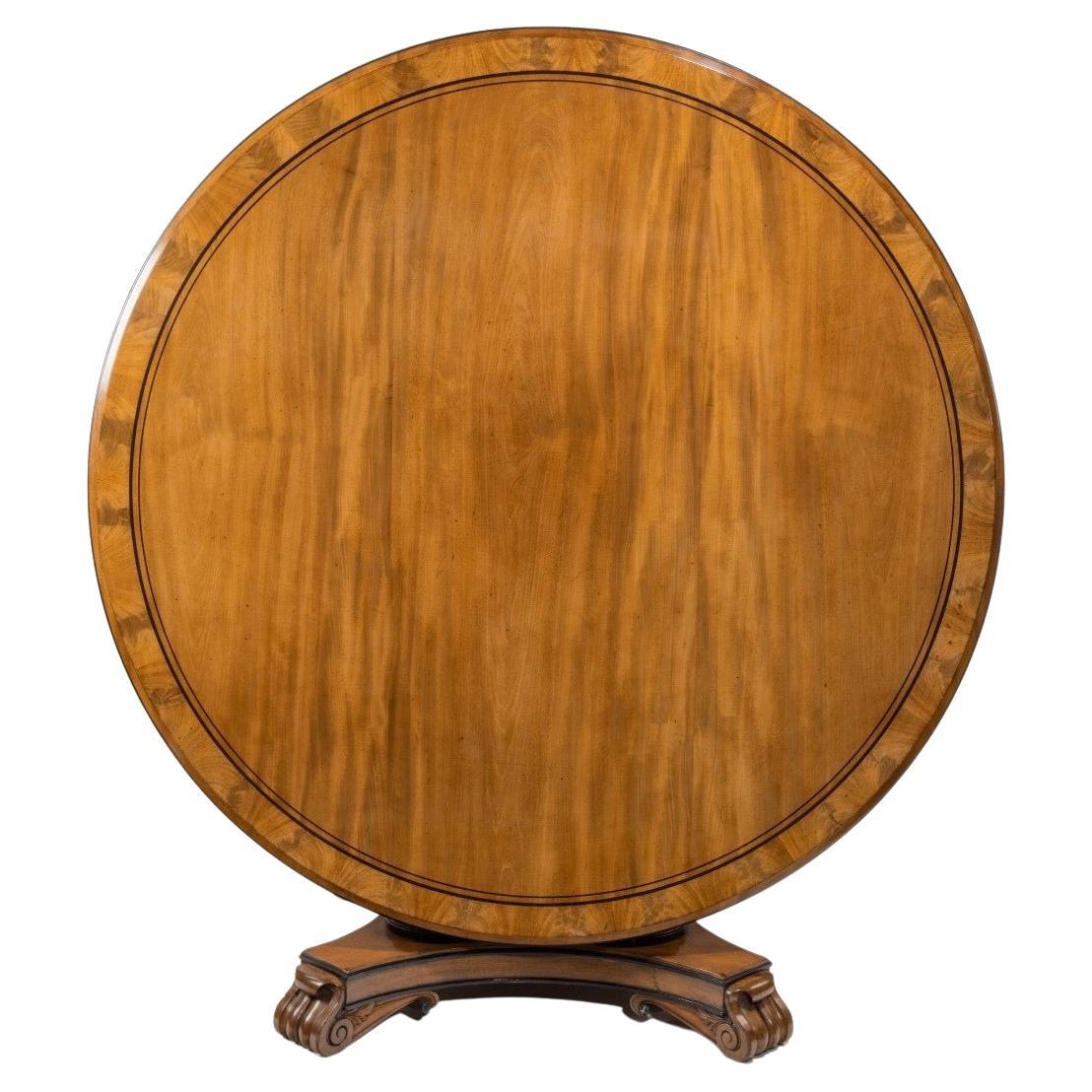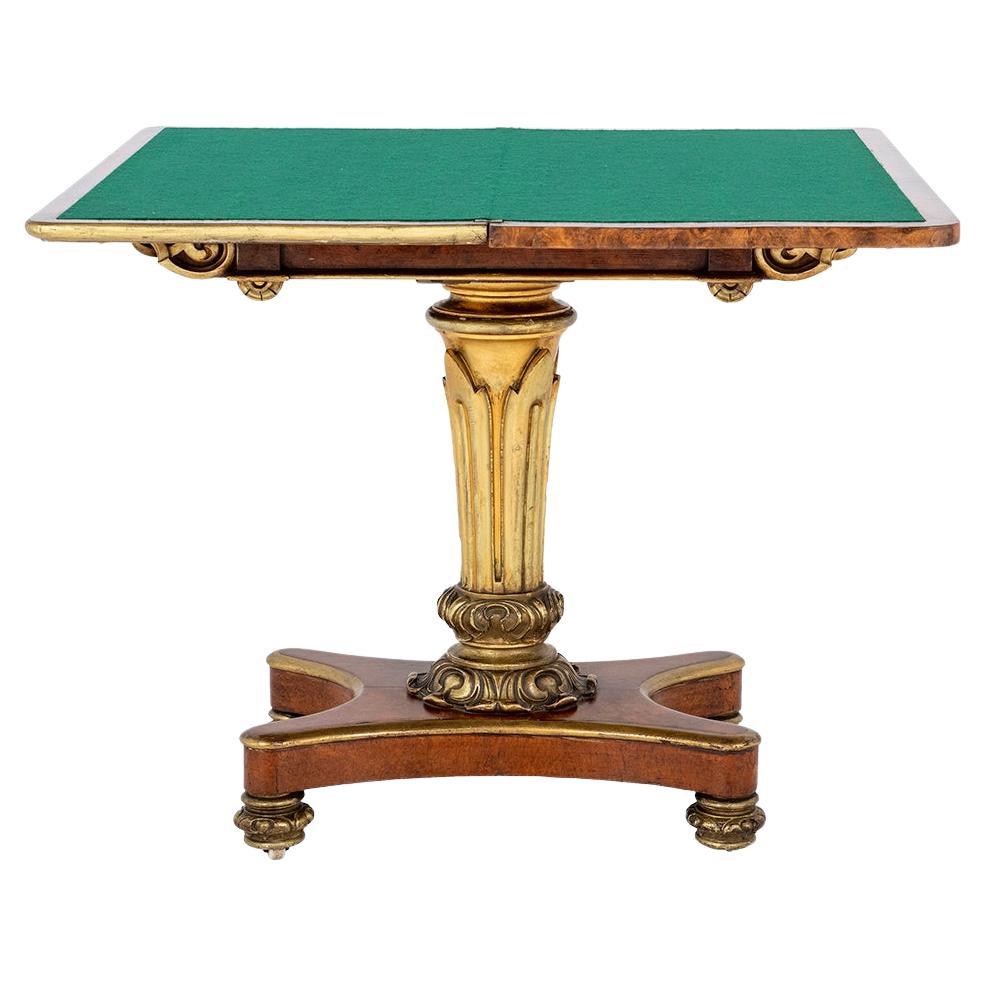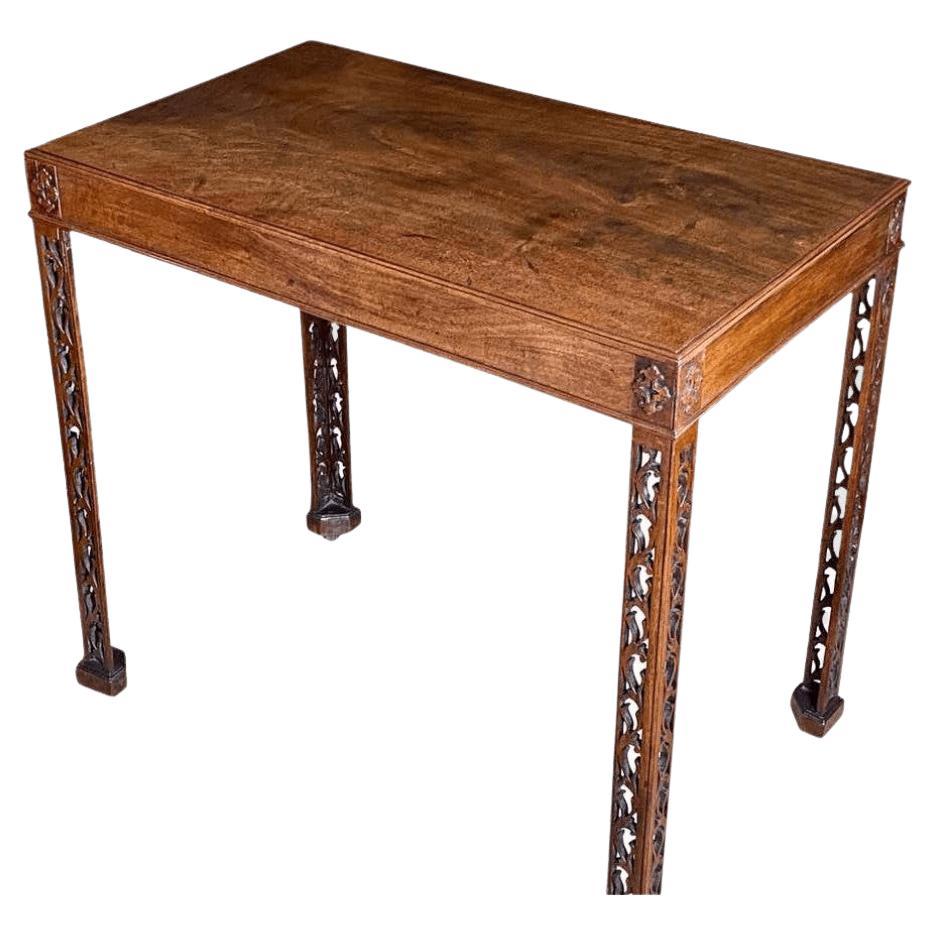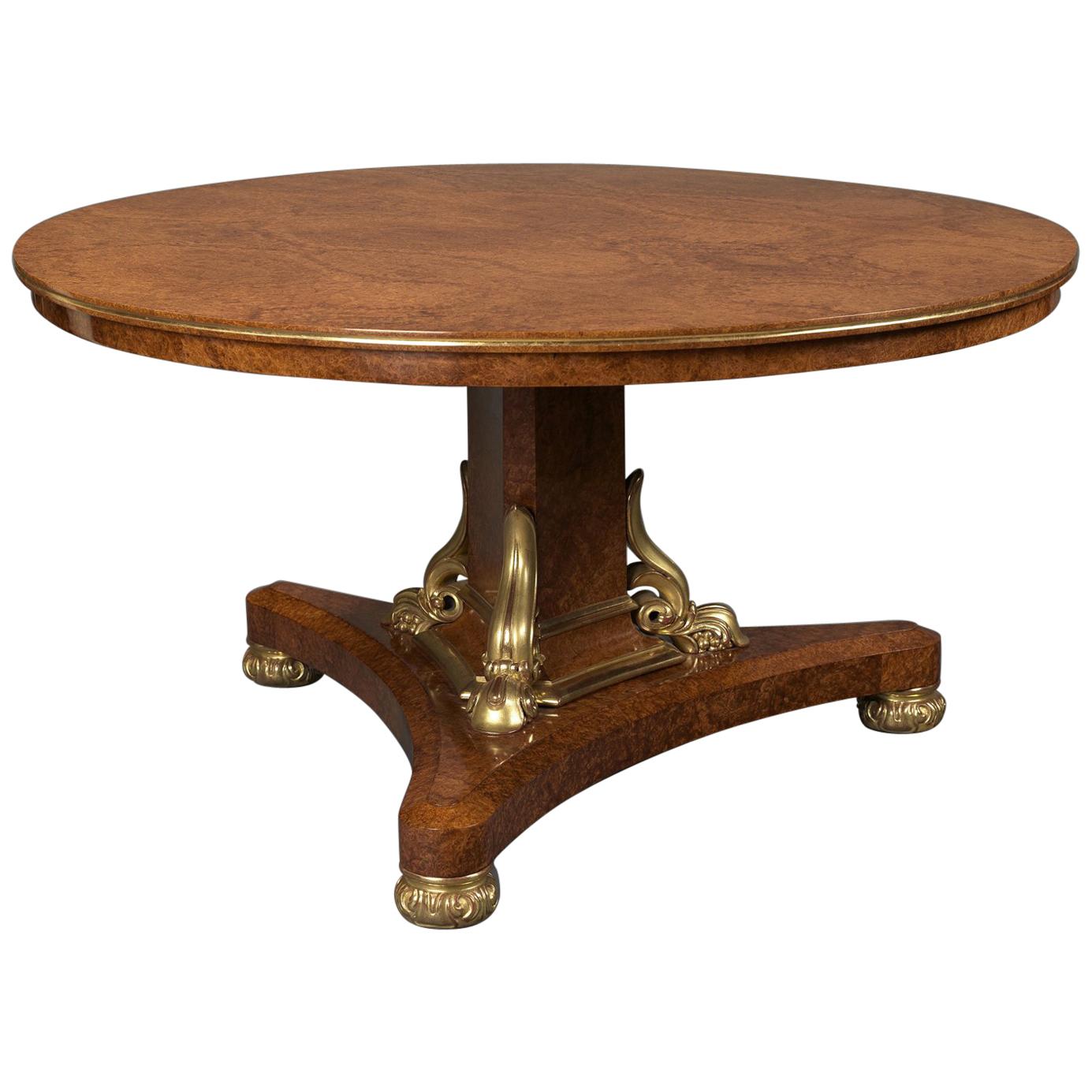Items Similar to Rare George IV Period Amboyna Inlaid and Carved Giltwood Centre Table
Want more images or videos?
Request additional images or videos from the seller
1 of 8
Rare George IV Period Amboyna Inlaid and Carved Giltwood Centre Table
About the Item
A magnificent library centre table of exhibition quality of the
George IVth period, in the Manner of Morel & Seddon.
Constructed in amboyna, with holly and specimen woods used in the inlays; rich and extensive employment of carving and gilding of exceptional quality; the table of end support form, conjoined by an addorsed tapering ring turned stretcher, carved with lobes; the end supports of triangulated form, rising from platforms supported by winged claw feet, carved with gilded foliates and acanthus leaves, with a stylised thyrsus staff issuing leaves and tendrils, inlaid in Holly; the sides sumptuously carved with gilded foliates; the serpentine top having pendant teardrop gilded finials at the angles; the thumbnail moulded edge gilded, having a running band of holly inlaid flowering anthemion in the outer reserve, and an exuberantly inlaid marquetry posy of spring flowers, in exotic woods to the centre.
Published in "British Furniture 1820 to 1920" by Christopher Payne, 2023, p. 71 & 73, illustrated fig. 2.17a-c.
Morel & Seddon of 13 Great Marlborough Street London
The partnership of Nicholas Morel, who had formerly worked for the Prince of Wales, later George IVth, on his residences at Carlton House and the Brighton Pavilion since the cusp of the 18th/19th Centuries, and George Seddon, of the large and established cabinet makers Seddon and Sons of Aldersgate Street came into being in 1827, when Morel, of French extraction, was awarded by George IVth the monumental task of refurbishing the apartments at Windsor Castle; his partner of choice was Seddon, whose expertise was coupled with a large workforce, as they were noted as the largest cabinet makers in London in the 18th Century, thus having the capacity to process large orders. The Windsor Castle commission was worth almost £200,000 to the company. Hugh Roberts book, 'For the King's Pleasure', published by Royal Collection Enterprises in 2001 illustrates many of the pieces made for the commission, and concordances may be noted between these, and our Library Table. The firm seemed to have had the Crown as their main clients, with further work being carried out for William IVth, although a large commission was carried out for the Marquess of Stafford in 1830 worth £15,000. Morel's name disappears from the records in 1831, and the company of G & T Seddon, although awarded the Royal Warrant in 1832, had great difficulty in extracting the £200,000 from the Crown for the Windsor commission, which led to a near bankruptcy in 1840. The firm eventually closed in 1868.
- Attributed to:Morel & Seddon (Cabinetmaker)
- Dimensions:Height: 28.5 in (72.39 cm)Width: 56.5 in (143.51 cm)Depth: 27 in (68.58 cm)
- Style:George IV (Of the Period)
- Materials and Techniques:
- Place of Origin:
- Period:
- Date of Manufacture:circa 1830
- Condition:Repaired: Each item has undergone careful inspection and restoration by a conservation specialist in order to guarantee the original quality and integrity of the object. Wear consistent with age and use.
- Seller Location:London, GB
- Reference Number:
About the Seller
5.0
Recognized Seller
These prestigious sellers are industry leaders and represent the highest echelon for item quality and design.
Gold Seller
These expertly vetted sellers are highly rated and consistently exceed customer expectations.
Established in 1964
1stDibs seller since 2012
41 sales on 1stDibs
Typical response time: 2 hours
Associations
The British Antique Dealers' AssociationLAPADA - The Association of Arts & Antiques Dealers
- ShippingRetrieving quote...Ships From: London, United Kingdom
- Return PolicyA return for this item may be initiated within 3 days of delivery.
More From This SellerView All
- George IV Carved Goncalo Alves Library or Sofa TableBy Gillows of Lancaster & LondonLocated in London, GBA Fine Library Table in the manner of Gillows of Lancaster Constructed in a very fine and distinctively marked Brazilian goncalo alves; of end support form, rising from a scrolled s...Category
Antique 19th Century English Georgian Sofa Tables
MaterialsWood
- Royal Table Made for Windsor Castle and Commanded by George IVLocated in London, GBA highly important and rare royal table made by Morel & Seddon for the Windsor Castle Commission, commanded by George IV Constructed in Amboyna, with ormolu gilt bronze mounts, hav...Category
Antique 19th Century English George IV Center Tables
MaterialsOrmolu
- Mid-19th Century Amboyna Octagonal Centre TableBy Johnstone, Jeanes & Co.Located in London, GBA good centre table by Johnstone & Jeanes of London Constructed in amboyna, with extensive marquetry inlays in specimen woods, and enhanced with parcel-gilt highlights. Rising from a cruciform platform base adorned with knops and having concealed castors, supporting the inlaid, and gently stepped and tapering centre column with stylized 'c' form brackets bracing the octagonal top, the outer guard band having English roses inlaid at the angles, with foliates with the national emblems of Scotland and Ireland, thistles and shamrocks. Stamped by the makers to the underside, 'Johnstone & Jeanes 67 Bond Street'. circa 1845 Published in “British Furniture 1820 to 1920” by Christopher Payne, 2023, p. 131, illustrated fig. 3.21. Johnstone, Jeanes & Co John Johnstone of Bond Street came to prominence after his collaboration with Robert Jupe, an 'upholder' of 47 Welbeck Street, Cavendish Square, London, who patented a remarkable design for a circular expanding dining table with a segmented top in 1835. After Jupe's death, the firm traded as 'Johnstone and Jeanes' from 1842 until 1880, having moved to 67 Bond Street and continuing the tradition of producing high quality furniture. After 1880, the company was re-named Johnstone & Norman. They exhibited at the Great Exhibition 1851, The International Exhibition of London in 1862, and The Paris Exhibition of 1878. Both the Royal Collection Trust and the Victoria & Albert Museum own stamped pieces of furniture in their collections. The company of Crace were designers and decorators to the Royal household from 1768 until 1899, working for every monarch from George the Third...Category
Antique Mid-19th Century English Center Tables
MaterialsAmboyna, Wood
- Exceptional Carved Giltwood Centre Table in the Louis XIV StyleLocated in London, GBAn exceptional giltwood table de Milieu in the Louis XIV style A true carver's delight, the giltwood center table of rectangular form supported on four baluster form legs interjoined by a stretcher, the free-standing table incorporating pierced scrolling aprons carved from solid wood to all the sides, the front and back decorated with a central female mask and flanking bearded male masks to the legs, while the sides are dressed with shell...Category
Antique 19th Century French Louis XIV Center Tables
MaterialsMarble
- 19th Century Grand Tour' Giltwood and Micromosaic Centre Table with Roman ScenesLocated in London, GBA Grand Tour Centre Table The Top Attributed to Cesare Roccheggiani The carved gilt wood base in the manner of George Smith having four monopedia supports, each depicting leopards heads atop, with paw feet below, and conjoined by an incurved stretcher base having carved stiff leaf decoration, and raised on castors; the circular platform of marmoro nero, with a stylised Greek Key border within double Malachite reserves; the central micromosaic roundel depicts The Vatican from St Peter's Square, surrounded by eight separate roundels of The Pantheon of the Gods; the smallest of Rome's seven hills, the Capitoline; The Mauseoleum of Hadrian on the Tiber; The Roman Forum, with the remnants of the Temple of Vespasian; The Colosseum; the Temple of Vesta; The Arch of Titus, and the Tomb of Cecilia Metella. English / Italian, Circa 1875 The attribution to Cesare Roccheggiani is supported by Jeanette Hanisee Gabriel, former curator of the Gilbert Collection and Honorary Curator for the Gilbert Collection at the Victoria & Albert Museum. Provenance: From a Noble family, the 6th Earl of Macclesfield (1811-1896) then by descent. The base is similar in design to designs published by George Smith's A Collection of Designs for Household Furniture and Interior Decoration, 1808. The taste for monopedia supports was of fashion, in the Regency period and models of such were displayed in the 1851 Great Exhibition. The Macclesfield coat of arms depicts a shield with a central chevron and three leopard's faces. Views of Roman monuments was the most popular theme used by mosaicists in Rome in the beginning of the 19th century, supplying the flow of wealthy Grand tourists from Northern Europe. From small gold boxes...Category
Antique 19th Century Italian Grand Tour Center Tables
MaterialsMalachite
- Decorative French Amboyna and Gilt Bronze Center TableLocated in London, GBA Library Centre Table in the Louis XVI Manner Constructed in amboyna, with purpleheart banding with gilt bronze mounts; of elliptical form, with gently everted angles; rising from ...Category
Antique Late 19th Century French Louis XVI Center Tables
MaterialsBronze
You May Also Like
- George IV Ebony-Inlaid Mahogany Tilt-Top Centre TableLocated in Lymington, HampshireA George IV ebony-inlaid mahogany tilt-top centre table, the circular top with a flame-veneered cross-banded border above a moulded frieze with ebony stringing and four small rectang...Category
Antique 1820s English George IV Center Tables
MaterialsEbony, Mahogany
- George IV Amboyna and Parcel Gilt Center TableLocated in Greenwich, CTA very fine George IV amboyna burl and giltwood center table attributed to T. & G. Seddon (formerly Morel and Seddon), circa 1835 The circular tilt-...Category
Antique 1830s English George IV Center Tables
MaterialsGiltwood, Amboyna
- A large George IV brass inlaid rosewood centre table attributed to GillowsBy Gillows of Lancaster & LondonLocated in Lymington, HampshireThe circular tilt top has a central field of book-matched, figured rosewood within a broad band of cut brass inlay. The edge is boldly carved with an acanthus and dart border. The central support is hexagonal in section with a broad central flange, raised on three powerful and ornately carved legs. The knees are presented as bold acanthus carved and gadrooned volutes. The lions’ paw feet have clearly defined knuckles and claws and enclose the original brass castors. English, circa 1825. See also S. Stuart, Gillows of Lancaster and London 1730-1840, Antique Collectors’ Club, Woodbridge, 2008, Vol II, pl. E.5, which shows a pattern for this table in a drawing room layout designed for G.Bamford about 1820-30. The drawing also shows a pair of bergères and a sofa which correspond to a suite supplied by Gillow & Co. in 1824 to Thomas Wynn...Category
Antique 1820s English George IV Center Tables
MaterialsBrass
- A George IV Amboyna and Giltwood Card Table Attributed to Morel and SeddonBy Morel & SeddonLocated in London, GBIntroducing a stunning George IV amboyna card table adorned with exquisite gilt wood decoration, showcasing the epitome of fine craftsmanship from the English circa 1830 era. This r...Category
Antique 1830s English George IV Card Tables and Tea Tables
MaterialsGiltwood, Amboyna
- Fine Chippendale Period Carved Silver Table, circa 1760Located in Lymington, GBA fine English Chippendale period silver table. George III. This is a particularly refined and beautifully-controlled version of a mid-18th century mahogany silver table. Raised on ...Category
Antique Mid-18th Century English George III Sofa Tables
MaterialsMahogany
- George IV Centre Table Attributed to Thomas & George Seddon, circa 1830By Thomas & George SeddonLocated in Brighton, West SussexA Very Fine George IV Parcel-Gilt Amboyna Centre Table Attributed to Thomas & George Seddon. English, Circa 1830. The table is of finely figured Amboyna with a circular tilt-top above a triform column with parcel-gilt scrolled supports. It is raised on a conforming plinth base with foliate carved feet and concealed castors. George Seddon was the eighth child of John Seddon of Blakelea, Lancashire. His father apprenticed him to George Clemaphon of Cripplegate to learn cabinet making. He became a master cabinet maker. (He was Master of the Joiner’s Company in 1795). In the early 1750s he was sufficiently successful to acquire London House, Aldersgate Street. It consisted of extensive workshops, where furniture was made, and showrooms to display the finished products. London House had formerly been a palace of the Bishops of London. The panelled state-rooms were ideal for the display of fashionable furniture; and the chapel and library made convenient workshops. When Seddon married, he converted the garden house and infirmary into the family home. Seddon was the biggest furniture maker of his time. His furniture store covered a two acre site in Aldersgate Street. His workshop there was described by London visitor Sophie v. La Roche in 1786: "We drove first to Mr. Seddon's, a cabinet-maker,...He employs four hundred apprentices on any work connected with the making of household furniture—joiners, carvers, gilders...Category
Antique Early 19th Century English George IV Center Tables
MaterialsWood
Recently Viewed
View AllMore Ways To Browse
Carved Inlaid Table
Tables Wood By George
Inlaid Gilded
Exhibition Quality Carved
Antique Wing Table
Gilded End Table
Gilded Table Flower
Giltwood Acanthus Table
Carved Inlaid Top Side Table
Library End Table
Amboyna Wood
Specimen Wood Tables
Teardrop Table
Carved Side Table With Finial
Carved Wood Library Table
Inlaid Carved Wood Side Table
Flower Wood Inlay Table
Specimen Side Table





